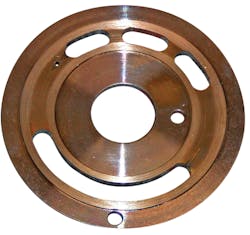This file type includes high-resolution graphics and schematics when applicable.
When it comes to ensuring the reliability of hydraulic components and systems, I cannot overemphasize the importance of:
• proactive rather than reactive maintenance;
• getting the fundamentals right—using the right oil and keeping it cool, dry, and clean;
• configuring your hydraulic equipment for the maintenance and reliability outcomes you desire; and
• using checklists to reveal hidden failures and prevent maintenance procedure failures that result in infant mortality of hydraulic components.
The reality, though, is even if you do all these things right, in-service failures can still happen. And when a hydraulic component does fail prematurely, the first question usually asked is: who pays? Typically, it is the “negligent” party. But determining who that is—and then convincing everyone involved—is always easier said than done.
Factory Fresh or Rebuilt?
If the failed hydraulic component is a new one from the factory, a shadow is often cast over the way it was installed and commissioned and the conditions it operated in. This includes oil cleanliness, oil temperature and viscosity, operating pressure, circuit design, and possible operator abuse. This is not to say manufacturing defects don’t occur. They can and do happen. But a new hydraulic component is usually given the benefit of any doubt—in the first instance, at least.
If, on the other hand, the failed hydraulic component is a rebuilt unit, not only is the way it was installed, commissioned, and the conditions it operated in called into question, so, too, is the quality of the rebuild.
Regardless of whether the component is new or rebuilt, when a premature failure occurs, it is essential that a proper and thorough analysis be conducted to determine the cause. In fact, failure analysis is an important proactive measure and an essential element of any preventative maintenance program. The logic for this is simple: If a component fails prematurely, and the cause of the failure is not identified and rectified immediately, then the replacement component is likely to suffer a similar fate.
Expertise in Question
Conducting failure analysis on hydraulic components is a highly specialized task. It requires a solid understanding of hydraulic circuits, the construction of hydraulic components, and their modes of failure. This means the task usually becomes the responsibility of the company who either manufactured or rebuilt the failed component. Understandably, this results in an absence of independence from the machine owner’s perspective.
I’ve been involved in many warranty claims—on both sides of the fence and in the middle—and this is what I have learned:
1. Failure analysis is not always conclusive.
2. If a repairer has made a mistake, he usually knows. But this doesn’t mean he’ll always admit it.
3. A lot of people get involved in failure analysis and warranty claims. But they don’t have the necessary expertise—and they shouldn’t.
4. Although contamination and cavitation can and do cause premature failures, they are incorrectly offered as explanation for a lot of hydraulic component failures.
As an example of points 3 and 4, some years ago I tried to get warranty on a new pump I had supplied for a project. It was a piston pump that started separating (the cylinder barrel was losing contact with the valve plate) in less than 100 hours. My own investigation showed that the valve plate was “hung up” on its dowel pin. This meant it was not sitting flat against the head or the cylinder barrel. Without question, this was an assembly fault at the factory.
The pump manufacturer’s salesman came along to examine what I’d found, and I explained everything in detail. The separation of the barrel from the valve plate resulted in scoring of their mating surfaces. The photos above and below this paragraph show typical damage of this nature. As soon as the manufacturer’s representative saw this, he was adamant the failure resulted from contamination, and there was no convincing him otherwise.
Such an outcome is frustrating to say the least. You do have to forgive hydraulic equipment owners from wondering if this sort of behavior is an intentional tactic by some component manufacturers to avoid all warranty claims.
Warranty Issues
Of course, the warranty on a new or rebuilt hydraulic component is not unconditional. Nor should it be. If you’ve ever read the warranty conditions for a hydraulic component, you would know that a number of circumstances can result in rejection of a warranty claim, if any is deemed to have caused the component to fail.
These include:
• improper storage or handling;
• interference or tampering with the component while in storage, such as the removal of parts—even if these parts are replaced prior to the unit being put into service;
• failure to follow proper commissioning or start-up procedures;
• incorrect setting or adjustment;
• contaminated oil;
• incorrect oil viscosity;
• damage caused by incorrect adjustment of the machine’s hydraulic or electronic system;
• damage caused by faulty components in the machine’s hydraulic or electronic system;
• improper machine operation.
Therefore, many things must be done to ensure that the life of a replacement hydraulic component—whether new or rebuilt—is not compromised during its storage, installation, commissioning, and, ultimately, its operation.
But who’s responsible for ensuring that what needs to be done actually gets done? Generally speaking, it’s the party that installs the component on the machine. If the guy who installs the component on the machine doesn’t know what he’s doing, is that the component supplier’s problem? It is if the installer works for the component supplier.
Flushing the System after Repair
This is why I advise machine owners whose primary concern is not voiding the warranty on a replacement hydraulic component gets the component supplier to install and commission it. This gives the supplier a free hand to carry out any related work deemed necessary—within reason, of course. An example might be flushing the hydraulic system to prevent the possibility of consequential damage caused by debris from the previous failure (if applicable).
Although flushing will involve some additional cost, it can be well worth the expense. If a warranty claim occurs, and the failure is attributed to incorrect installation, commissioning, or incorrect adjustment of the hydraulic system’s settings, responsibility for the failure falls back on the supplier of the component. That’s because it was the supplier’s responsibility to get all these things right.
And if time pressures won’t allow the job to be done right (there’s no time to flush the system to remove all debris from a previous catastrophic failure), then that’s not the component supplier’s fault. It’s fair and reasonable, then, that any risk of premature failure from such omission transfers to the machine owner.
Similarly, if it’s not practical for the supplier to install the component, then the onus falls on the machine owner’s technician to know what he’s doing and/or seek the necessary advice. At the very least, he should request a detailed commissioning procedure and checklist from the component’s supplier. This procedure should be carefully followed and properly documented, so that it can be referred to in the event of a warranty claim.
If a warranty claim does occur, and the failure is attributed to incorrect commissioning, then at least some of the responsibility for the failure falls back on the component supplier if it can be demonstrated that the supplied commissioning procedure was followed.
Smart hydraulic component suppliers take the lead in this issue by advising and warning their customers of the potential pitfalls—for example, the attachment of an oil-resistant warning tag to each component supplied, which outlines the essential steps to be followed during commissioning. However, a tag cannot be expected to cover all situations; therefore, it is not a substitute for proper training and experience.
And as already stated, contamination is an all-too-common excuse for rejecting warranty claims. So when practical, it’s also wise to take an oil sample prior to replacing hydraulic components. This establishes a reference cleanliness level for the fluid in the system if a premature failure occurs and contamination is cited as a basis for rejecting the claim.
In summary, premature failures and the warranty claims that follow almost always result in win/lose outcomes. So my best advice, regardless of whether you’re a supplier or repairer of hydraulic components, or a machine owner, is take all reasonable steps to ensure you don’t find yourself in a warranty situation in the first place. In other words, doing everything you possibly can to proactively avoid premature failures. And this means acting on the advice contained in The Hydraulic Maintenance Handbook!
Brendan Casey is hydraulics specialist with an MBA and more than 25 years experience in the design, maintenance, and repair of mobile and industrial hydraulic equipment. He is the founder of HydraulicSupermarket.com, the author of several books and an enewsletter covering hydraulics technology, and he writes the Hydraulics at Work blog on our website. For information on his resources, visit www.hydraulicsupermarket.com. To order his book, The Hydraulic Maintenance Handbook, go to bit.ly/HP0616THMH.
Looking for parts? Go to SourceESB.
This file type includes high-resolution graphics and schematics when applicable.





